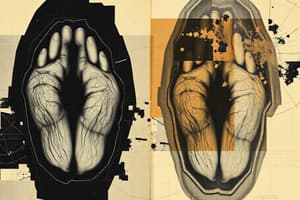Podcast
Questions and Answers
What contributes to tissue damage in wound ballistics?
What contributes to tissue damage in wound ballistics?
- Bullet color and shape
- Bullet weight and texture
- Bullet size and deformity (correct)
- Bullet speed and trajectory
What happens to hollow point and soft nose bullets on impact?
What happens to hollow point and soft nose bullets on impact?
- They ricochet off the surface
- They flatten out and result in larger surface area involved (correct)
- They break into smaller pieces
- They remain intact and penetrate deeper
What is the term used to describe the forward motion of a bullet indenting the skin and abrading the margin of entry wound?
What is the term used to describe the forward motion of a bullet indenting the skin and abrading the margin of entry wound?
- Tattooing
- Abraded margin (correct)
- Singeing
- Smudging
What is the term used to describe the blackening deposition of soot from partially burnt gases?
What is the term used to describe the blackening deposition of soot from partially burnt gases?
What is the term used to describe the unburned, partially burned and burning propellant grains abrading and embedding in skin?
What is the term used to describe the unburned, partially burned and burning propellant grains abrading and embedding in skin?
What is the term used to describe the burning hot gases from muzzle at close range?
What is the term used to describe the burning hot gases from muzzle at close range?
What is the term used to describe the skin impact against muzzle produced by discharge gases or temporary cavity formation in contact and near contact fire?
What is the term used to describe the skin impact against muzzle produced by discharge gases or temporary cavity formation in contact and near contact fire?
What is the term used to describe the abrasion collar/marginal abrasion/contusion ring/abrasion ring caused by the forward motion of a bullet?
What is the term used to describe the abrasion collar/marginal abrasion/contusion ring/abrasion ring caused by the forward motion of a bullet?
What happens to a larger bullet in wound ballistics?
What happens to a larger bullet in wound ballistics?
What happens to unburned, partially burned and burning propellant grains in wound ballistics?
What happens to unburned, partially burned and burning propellant grains in wound ballistics?
What is the definition of a questioned document?
What is the definition of a questioned document?
What is the origin of the term 'document'?
What is the origin of the term 'document'?
What is a holograph document?
What is a holograph document?
What is the responsibility of a document examiner?
What is the responsibility of a document examiner?
What is the scientific process of investigating questioned/disputed documents called?
What is the scientific process of investigating questioned/disputed documents called?
What is the role of a fraud investigator in document examination?
What is the role of a fraud investigator in document examination?
What is the definition of a questioned document?
What is the definition of a questioned document?
What is the origin of the term 'document'?
What is the origin of the term 'document'?
What is a holograph document?
What is a holograph document?
What is the responsibility of a document examiner?
What is the responsibility of a document examiner?
What is a fraud investigator?
What is a fraud investigator?
What is the difference between a document examiner and a paper and ink specialist?
What is the difference between a document examiner and a paper and ink specialist?
Flashcards are hidden until you start studying
Study Notes
Wound Ballistics
- Tissue damage is contributed by the forward motion of the bullet, temporary cavity formation, and the deposition of soot and propellant grains in the skin.
- Hollow point and soft nose bullets mushroom or deform on impact, causing larger wound cavities.
Bullet Impact
- The forward motion of a bullet indenting the skin and abrading the margin of the entry wound is called a "abrasion collar" or "marginal abrasion".
- The burning hot gases from the muzzle at close range can cause additional damage to the skin.
Bullet Composition
- Larger bullets cause larger wound cavities due to their increased size and kinetic energy.
- Unburned, partially burned, and burning propellant grains can abrade and embed in the skin, causing additional damage.
Document Examination
- A questioned document is a document whose authenticity or validity is disputed.
- The term "document" originates from the Latin word "documentum", meaning "lesson" or "teaching".
- A holograph document is a document written entirely in the handwriting of the signer.
- The responsibility of a document examiner is to investigate and provide expert opinion on the authenticity of disputed documents.
- The scientific process of investigating questioned documents is called Questioned Document Examination (QDE).
- A fraud investigator specializes in investigating fraudulent documents and identifying forgeries.
- The main difference between a document examiner and a paper and ink specialist is that a document examiner focuses on the handwriting, signatures, and other aspects of a document, while a paper and ink specialist focuses on the physical materials used in the document.
Studying That Suits You
Use AI to generate personalized quizzes and flashcards to suit your learning preferences.



